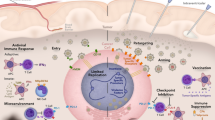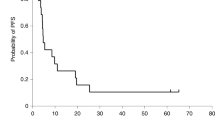Abstract
Herpes simplex virus thymidine kinase (HSV-tk) gene transfer and ganciclovir (GCV) administration have been suggested for the treatment of malignant gliomas. To understand tissue responses and possible ways to improve the treatment effect, we studied tumor growth, tissue reactions, and survival time after HSV-tk/GCV treatment in a syngeneic BT4C rat glioma model by mixing various ratios of stably transfected HSV-tk-expressing BT4C-tk glioma cells with wild-type BT4C glioma cells (percentage of BT4C-tk cells: 0%, 1%, 10%, 30%, 50%, and 100%), followed by injection into BDIX rat brains (n = 79). With the exception of some animals with end-stage tumors, very little astroglia or microglia reactivity was detected in the wild-type tumors as analyzed by immunocytochemistry using glial fibrillary acid protein (GFAP)-, vimentin-, human histocompatibility leukocyte antigen-DR-, OX-42-, and CD68-specific monoclonal antibodies. After 14 days of GCV treatment, tumors induced with ≥10% BT4C-tk cells showed a significant reduction in tumor size (P < .05) and prolonged survival time (P < .01). Astrogliosis, as indicated by a strong GFAP and vimentin immunoreactivity, was seen in the tumor scar area. GFAP and vimentin reactivity was already present after the GCV treatment in tumors induced with 1% BT4C-tk cells. Much less human histocompatibility leukocyte antigen-DR-positive microglia was seen in the treated animals, indicating low microglia reactivity and immunoactivation against the tumor. However, GCV-treated tumors were positive for apoptosis, indicating that apoptosis is an important mechanism for cell death in the BT4C-tk glioma model. Our results suggest that ≥10% transfection efficiency is required for a successful reduction in BT4C glioma tumor size with HSV-tk/GCV treatment in vivo. Tissue reactions after 14 days of GCV treatment are characterized by astrogliosis and apoptosis, whereas microglia response and immunoactivation of the brain cells appear to play a minor role. Stimulation of the microglia response by gene transfer or other means might improve the efficacy of the HSV-tk/GCV treatment in vivo.
This is a preview of subscription content, access via your institution
Access options
Subscribe to this journal
Receive 12 print issues and online access
$259.00 per year
only $21.58 per issue
Buy this article
- Purchase on Springer Link
- Instant access to full article PDF
Prices may be subject to local taxes which are calculated during checkout
Similar content being viewed by others
Author information
Authors and Affiliations
Rights and permissions
About this article
Cite this article
Sandmair, AM., Turunen, M., Tyynelä, K. et al. Herpes simplex virus thymidine kinase gene therapy in experimental rat BT4C glioma model: Effect of the percentage of thymidine kinase-positive glioma cells on treatment effect, survival time, and tissue reactions. Cancer Gene Ther 7, 413–421 (2000). https://doi.org/10.1038/sj.cgt.7700132
Received:
Accepted:
Published:
Issue Date:
DOI: https://doi.org/10.1038/sj.cgt.7700132
Keywords
This article is cited by
-
Tomato thymidine kinase-based suicide gene therapy for malignant glioma—an alternative for Herpes Simplex virus-1 thymidine kinase
Cancer Gene Therapy (2015)
-
Improved therapeutic effect on malignant glioma with adenoviral suicide gene therapy combined with temozolomide
Gene Therapy (2013)
-
Specific Inhibition of SRC Kinase Impairs Malignant Glioma Growth In Vitro and In Vivo
Molecular Therapy - Nucleic Acids (2012)
-
(Strept)avidin-displaying lentiviruses as versatile tools for targeting and dual imaging of gene delivery
Gene Therapy (2009)
-
Truncated vesicular stomatitis virus G protein improves baculovirus transduction efficiency in vitro and in vivo
Gene Therapy (2006)



